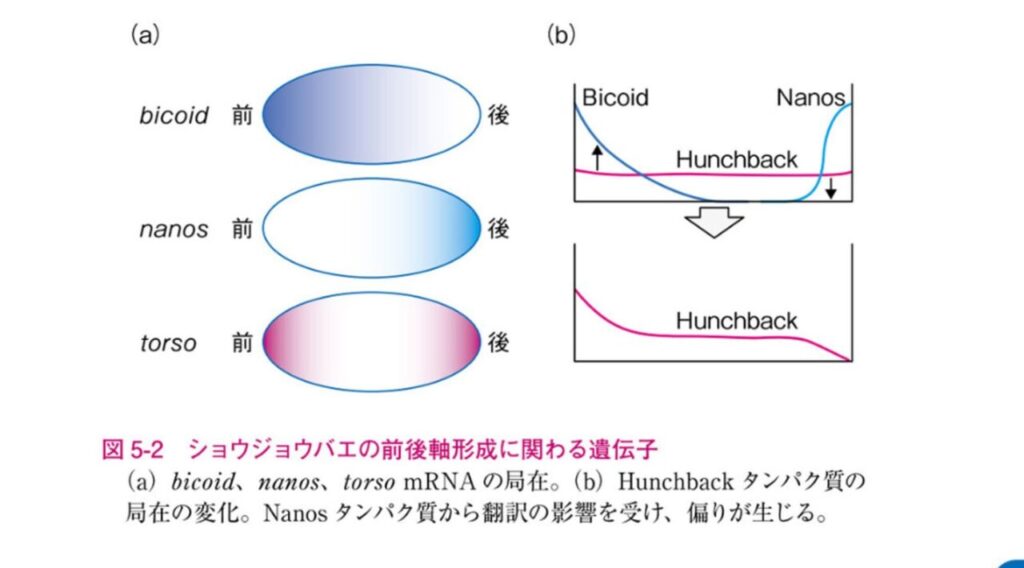Introduction.
To catch up on basic research areas, here is a book I picked up to study developmental biology for the first time since I was in molecular biology in medical school.
When I studied molecular biology in the first or second year of medical school, I was struggling with too many things to remember because I was cramming for the exam just to pass it (some of my classmates were reading “The Cell” in Western books, and I was impressed). It is very interesting to see how they managed to create such a complex life mechanism from a single cell.
Basic principles of animal development: concentration gradients and gene relays
The blueprint (i.e., genome sequence) that cells have is the same, but the actual human body that is created is not. Moreover, it is too complex. The “bias of matter and its combination” is responsible for this complexity.
Yet, how does the bias come about; it is unlikely to emerge on its own from zero.
- Some information is already formed in the egg OR/AND gravity
It is believed that embryo patterning is carried out by
Embryo patterning
- Whether or not embryonic patterning is already present in the egg from the start depends on the egg.
- Mosaic eggs: first to be determined. Sea urchin
- Regulated eggs: pattern formation is determined after splitting into split balls, not initially. Frogs.
Initial protein concentration gradient
- In many animals, proteins and mRNAs supplied by maternal effect genes form specific concentration gradients during the early stages of development.
- These concentration gradients provide location information to cells within the embryo and determine the fate of specific regions.
gene relay format
- Based on the positional information induced by the initial concentration gradient, genes are sequentially expressed in the following stages, and complex pattern formation proceeds.
- This process of gene relay is common to many animals and is the basic mechanism for determining developmental complexity.
Sectional Regulation in Drosophila
Taking Drosophila as an example, the anteroposterior and dorsoventral axes are first determined.
The anterior-posterior axis is determined by the localization of three mRNAs, Bicoid, Nanos, and Hunchback, to specific locations in the egg, respectively. The concentration gradient of proteins synthesized from these mRNAs determines the anterior-posterior axis.

Subsequently, with respect to somitization along the anterior-posterior axis and subsequent developmental processes, the complex patterning of the embryo is achieved through the stepwise and sequential expression of genes in a gene relay format (gene network).
- Gap genes form a pattern of expression over a wide area.
- Pair-rule genes form even finer segments.
- Segment polarity genes determine the front and back boundaries within a segment.
- Homeotic genes establish the identity of each segment.

Although there are considerable differences among the animals in the mode of egg splitting and the body structure that emerges as the final output, the following two points are the same with respect to the mechanism of development from the egg.
- Initially, the protein concentration gradient determines the area.
- The complexity is then determined by the gene relay format
So, the technique of organ differentiation using stem cells also depends on the concentration and timing of the attached drug, and the concept of concentration gradients in early development is applied.
Differentiation and development of the human triad
The differentiation and development of the human triad (ectoderm, mesoderm, and endoderm) follows basic principles common to many animals, but there are some specific processes and mechanisms.
Personally, I still wonder why nerves are differentiated from the ectoderm.

Formation of tissues and organs by morphogenetic movement
So far, it seems that the complexity of the animal can be achieved as long as there is a protein concentration gradient and subsequent gene relay mechanism, but that is actually not enough.
Gene relays control cell differentiation and fate, but not the mechanism by which cells actually move to their proper place in the embryo.
Cells need to be physically moved and placed in the proper position so that certain tissues and organs can have the correct shape.
For this reason, organisms have a mechanism called morphogenetic movement (spatial movement of cells).
Morphogenetic movements, but there are a wide variety of types. Broadly speaking, the two types are as follows
- Depression (concavity): deformation of tissue as the sum of the deformations of each cell
- Migration: deformation of tissue caused by the movement of individual cells

For example, in neural tube formation, cells must move in a specific direction in order for the neural plate to contract and form the neural tube. This cannot be accomplished by gene relay alone.
And now that we’ve come this far, I personally have a question.
‘Isn’t it theoretically possible to control the spatial arrangement of the genes by gene relay alone?’ Why wasn’t that method chosen?”
That is to say.
In response to this, life probably chose the mechanism of morphogenetic movement in the course of evolution for the following two reasons.
- Since cell and tissue migration uses physical forces (e.g., cell contraction, intercellular adhesion, interaction with extracellular matrix), was it more efficient to use signaling between adjacent cells and tissues (e.g., Notch signaling, Wint signaling, Hodgson signaling) rather than gene regulation?
- Perhaps it would have been better to incorporate another mechanism of interaction between adjacent cellular tissues a posteriori to ensure the accuracy of spatial placement, since setting up a function for gene regulation to spatial placement would have been error prone? Was this because regional determination by protein concentration gradients was very effective in providing rough location information in early embryos, but not for subsequent detailed placement, which would require fine-tuning of gene expression and could easily be subject to error due to environmental fluctuations and internal noise? The analogy is believed to be.
Is it like determining the role that each substance performs at each stage of generation to prevent the accumulation of errors?
This is a completely different analogy, but if we go down the chain of command of a company, the gene relay makes general policy decisions for the company at the board of directors, etc., while the morphogenetic movement adjusts staffing and issues within or between divisions? I’m not a rice cake maker, but the details are better left to the parties involved, since they know them better. It is better to leave the details to the parties concerned, since they know them better.
Regardless, it is believed that current life forms effectively form complex body structures and functions by combining three different mechanisms: protein concentration gradients, gene relays, and morphogenetic movements.
I think that biochemistry is a science that has an answer as a phenomenon (nature already has the answer), but is trying to unravel the black box of the mechanism inside so that humans can recognize it, so it seems interesting despite its peculiarities in this respect.




